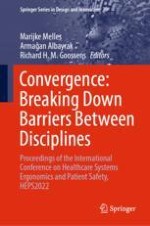This book presents the proceedings of the 7th conference Healthcare Systems Ergonomics and Patient Safety (HEPS), held in Delft, The Netherlands on November 2-4, 2022, which was endorsed by the International Ergonomics Association (IEA). Contributions focus on the integration of knowledge, methods, and expertise from the disciplines of Human Factors/Ergonomics and of Medicine and Health in order to contribute to a safe and humane, high-quality healthcare system. Through breaking down the barriers between disciplines, they foster a framework of scientific knowledge, expertise and best practices to create the future of health and healthcare. The proceedings include papers from researchers and practitioners, scientists and physicians, institutional leaders, managers and policy makers that contribute to constructing the Human Factors and Ergonomics approach across a variety of methodologies, domains and productive sectors.
